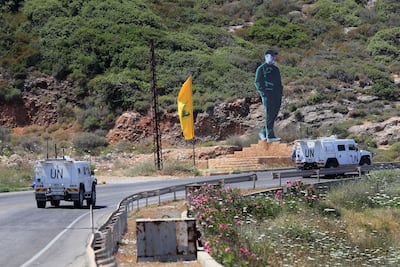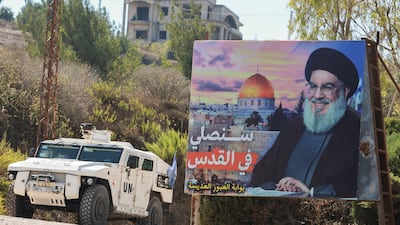Earlier this month, a salvo of 34 rockets was fired at Israel from southern Lebanon. While this was portrayed as retaliation for attacks by Israeli police against Palestinians praying at Al Aqsa Mosque in Jerusalem, the episode had more profound implications. It was an effort by pro-Iranian groups, namely Hezbollah, Hamas and Islamic Jihad, to change the rules of engagement in their conflict with Israel.
In January, the secretary general of Hezbollah, Hassan Nasrallah, had linked the party’s actions to developments at Al Aqsa. Nasrallah had stated that any change in the status quo governing Israeli-Arab relations on Haram Al Sharif, where Al Aqsa is located, could lead to a regional explosion. His comments came amid signs that extreme right-wing elements in Israel’s government might try to alter this state of affairs.
However, Nasrallah’s threats had to be taken in the context of broader dynamics, namely Israel’s sustained attacks against Iranian and Hezbollah forces in Syria, which extended to bombing pro-Iranian militias on the Syria-Iraq border. Iran and Hezbollah have been unable to retaliate against such operations, creating an imbalance in the deterrence equation between Iran and its proxies and Israel.

Earlier this year, there were signs that Hezbollah was already trying to modify this reality. On March 13, an explosion at the Megiddo junction in northern Israel injured an Israeli citizen (who happened to be an Arab). The suspect who planted the bomb, and who has not been identified, infiltrated Israel from Lebanon, and was later killed in northern Israel. Israel concluded that Hezbollah was behind the action.
Two weeks later, the rockets were fired at Israel. Again, it was unclear who the perpetrators were, though the area from where the rockets were launched is known to be controlled by Hezbollah. While some commentators speculated that Hezbollah may not have known about the rocket attack, this appears far-fetched. Rather, it seemed part of a wider effort by the party and Iran to show that they too could strike Israel when and however they wanted to, while maintaining deniability.
As Iran and Hezbollah have been unable to consolidate a new front along Syria’s boundary with the occupied Golan Heights, they appear to have fallen back on an alternative plan. The plan is to co-ordinate more closely with Hamas and Islamic Jihad in such a way as to establish a unified front around Israel from the Gaza Strip to southern Lebanon to, when possible, south-eastern Syria.
Such a front, the Iranians appear to believe, would represent considerable leverage over Israel, particularly at a time when there is a genuine fear that the Israelis may try to impair Iran’s nuclear programme. With the US increasingly disengaged from the Middle East and with Saudi Arabia and Iran having recently reconciled, officials in Tehran may feel that Israel will act now before its window of opportunity closes.
The timing of the rocket attack soon after the Saudi-Iranian reconciliation did not appear to be coincidental. One of the prerequisites to that opening was a winding down of the Yemen conflict. In light of this, the Iranians appear to have shifted their focus to Israel. This has involved a key development on the Palestinian front.
Hezbollah is helping Hamas to build a military presence in Lebanon, while welcoming several of its leaders to the country, including Khalil Al Hayyeh and Zaher Jabareen, as well as Hamas’ deputy chairman Saleh Arouri. An apparent indication of this presence was an explosion in the southern Lebanese refugee camp of Burj Al Shemali in December 2021, which killed Hamza Shahin, a Hamas member.
It is unclear whether the explosion was an accident or the result of an Israeli military operation. However, as my colleague Mohanad Hage Ali, who has followed Hamas’ trajectory in Lebanon closely, observed, the explosion was preceded by an Israeli news report that Hamas had established a branch in Lebanon near Tyre, where the Burj Al Shemali camp is located. This hinted at the possibility of Israeli involvement.
There are definite risks for Hezbollah if it moves ahead with unifying the Lebanese and Palestinian fronts. The Shiite community has bad memories of the Palestinian guerrilla presence in Lebanon, starting in the late 1960s and ending in 1982. The community paid a high price from Israeli retaliation against Palestinian factions, and the Amal movement, today a close ally of Hezbollah, notably fought the Palestinians.
The population of southern Lebanon, a majority of which supports Hezbollah and Amal, is not likely to welcome a situation where a Palestinian agenda leads to a resumption of Israeli attacks against their villages. On top of this, the catastrophic economic situation in Lebanon has meant that many of them would not have the means to rebuild their homes and livelihoods after Israel engages in retribution.
This may suggest that Hezbollah hopes to maintain a limited level of operations, one preserving a facade of deniability. If so, the party's strategy may be to keep the southern front on a low burn, while playing an increasing role in internal Palestinian politics. The declining sway of the Palestinian Authority encourages such ambitions.
However, Hezbollah has to be careful that the situation does not get out of hand. A new war with Israel would represent a major setback for the party, at a time when the Lebanese have no cushion to accept a further blow to their economic well-being and that of their country. The aftermath of such a war would be very different than in 2006, and could turn most communities, among them the Shiites, decisively against Hezbollah.


